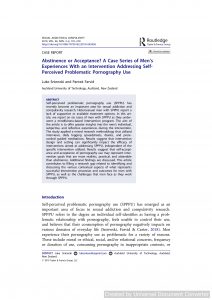Legal Considerations
Abstinence or Acceptance?
 Full Article Title: Abstinence or Acceptance? A Case Series of Men’s Experiences With an Intervention Addressing Self-Perceived Problematic Pornography Use
Full Article Title: Abstinence or Acceptance? A Case Series of Men’s Experiences With an Intervention Addressing Self-Perceived Problematic Pornography Use
Open Access: Yes
Abstract
Self-perceived problematic pornography use (SPPPU) has recently become an important area for sexual addiction and compulsivity research. Heterosexual men with SPPPU report a lack of supportive or available treatment options. In this article, we report on six cases of men with SPPPU as they underwent a mindfulness-based intervention program. The aim of the article is to offer greater insights into the men’s individual, subjective, and reflective experiences during the intervention. The study applied a mixed research methodology that utilized interviews, daily logging spreadsheets, diaries, and prerecorded guided meditations. Results suggest that intervention design and setting can significantly impact the efficacy of interventions aimed at addressing SPPPU, independent of the specific intervention utilized. Results suggest that self-acceptance and acceptance of pornography use may represent intervention goals that are more realistic, practical, and attainable than abstinence. Additional findings are discussed. This article contributes to filling a research gap related to identifying and discussing the various contextual aspects of what represents successful intervention processes and outcomes for men with SPPPU, as well as the challenges that men face as they work through SPPPU.
Citation
Sniewski, L., & Farvid, P. (2019). Abstinence or acceptance? A case series of men’s experiences with an intervention addressing self-perceived problematic pornography use. Sexual Addiction & Compulsivity, 26(3-4), 191–210. https://doi.org/10.1080/10720162.2019.1645058
